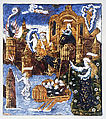The Fall of Troy; Helen Takes Refuge in the Sanctuary of Vesta; Venus Counsels Aeneas; Juno Encourages the Greeks (Aeneid, Book II)
European of the Renaissance period viewed ancient Rome not only as the origin of Italian civilzation but also the geographic center of a lost golden age. This plaque belongs to a series of at least eighty Limoges enamels illustrating events from Virgil’s Aeneid. The Latin epic poem tells the story of the legendary hero Aeneas, who escaped the sack and burning of Troy by the Greeks and, after wandering for some time, settled in Italy, where his descendants founded Rome.
The scenes are not, however, the product of the enameler's imagination; rather, they are close copies of the woodcut illustrations for the edition of the Latin poet’s Opera printed by Johann Grüninger in Strasbourg in 1502. The same woodcuts were used again for the edition published in Lyon in 1517. The anonymous painter of the enamels may have used either the Strasbourg of the Lyon edition as his model, but the enamels are somewhat later than either edition. Because of changes made at an early point in the series in the technique employed for counterenameling the plaques (enameling the reverse side), it seems likely that most of them were painted after about 1530 or 1533.
Due to rights restrictions, this image cannot be enlarged, viewed at full screen, or downloaded.


